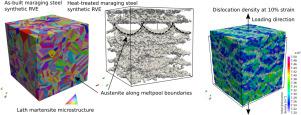当前位置:
X-MOL 学术
›
Int. J. Plasticity
›
论文详情
Our official English website, www.x-mol.net, welcomes your
feedback! (Note: you will need to create a separate account there.)
Dual-phase polycrystalline crystal plasticity model revealing the relationship between microstructural characteristics and mechanical properties in additively manufactured maraging steel
International Journal of Plasticity ( IF 9.4 ) Pub Date : 2024-07-15 , DOI: 10.1016/j.ijplas.2024.104058 Jakub Mikula , Guglielmo Vastola , Yong-Wei Zhang
International Journal of Plasticity ( IF 9.4 ) Pub Date : 2024-07-15 , DOI: 10.1016/j.ijplas.2024.104058 Jakub Mikula , Guglielmo Vastola , Yong-Wei Zhang

|
To elucidate the relationship between microstructural characteristics and mechanical properties in additively manufactured (AM) maraging steel, this study introduces a computational approach that addresses two fundamental challenges. Firstly, it addresses the creation of representative volume elements (RVEs) that mimic the observed microstructural complexities, such as meltpool boundaries, prior austenite grains, packets and blocks of lath martensite. This is accomplished through the application of Potts Monte-Carlo methods and grain segmentation techniques in accordance with the Kurdjumov–Sachs orientation relationship. Secondly, this study develops a comprehensive crystal plasticity (CP) model encompassing both bcc and fcc plasticity. Inspired by atomistic and discrete dislocation dynamics studies, the proposed CP model incorporates characteristics intrinsic to bcc plasticity, including non-Schmid effects, dislocation and precipitate strengthening, and Hall–Petch type strengthening of elongated martensitic blocks. Utilizing the created RVEs and the proposed CP framework, finite element simulations are conducted based on an update-Lagrangian formulation. The purpose of this study is to investigate the deformation behavior, texture evolution, tension–compression asymmetry, and evolution in dislocation density in RVEs representative of as-built and heat-treated samples of maraging steel. This computational approach and its findings deepen our understanding of the intricate interplay between microstructural characteristics and mechanical properties in maraging steel and also provide valuable guidelines for refining its additive manufacturing and heat treatment processes.
中文翻译:

双相多晶晶体塑性模型揭示增材制造马氏体时效钢微观结构特征与机械性能之间的关系
为了阐明增材制造 (AM) 马氏体时效钢的微观结构特征和机械性能之间的关系,本研究引入了一种解决两个基本挑战的计算方法。首先,它解决了模拟观察到的微观结构复杂性的代表性体积单元(RVE)的创建,例如熔池边界、原奥氏体晶粒、板条马氏体包和块。这是通过应用 Potts Monte-Carlo 方法和根据 Kurdjumov-Sachs 取向关系的晶粒分割技术来实现的。其次,本研究开发了一个涵盖 bcc 和 fcc 可塑性的综合晶体可塑性 (CP) 模型。受原子和离散位错动力学研究的启发,所提出的 CP 模型结合了 bcc 塑性的固有特征,包括非施密德效应、位错和沉淀强化以及细长马氏体块的 Hall-Petch 型强化。利用创建的 RVE 和提出的 CP 框架,基于更新拉格朗日公式进行有限元模拟。本研究的目的是研究代表马氏体时效钢竣工和热处理样品的 RVE 的变形行为、织构演变、拉压不对称性和位错密度演变。这种计算方法及其研究结果加深了我们对马氏体时效钢微观结构特征和机械性能之间复杂相互作用的理解,并为改进其增材制造和热处理工艺提供了宝贵的指导。
更新日期:2024-07-15
中文翻译:

双相多晶晶体塑性模型揭示增材制造马氏体时效钢微观结构特征与机械性能之间的关系
为了阐明增材制造 (AM) 马氏体时效钢的微观结构特征和机械性能之间的关系,本研究引入了一种解决两个基本挑战的计算方法。首先,它解决了模拟观察到的微观结构复杂性的代表性体积单元(RVE)的创建,例如熔池边界、原奥氏体晶粒、板条马氏体包和块。这是通过应用 Potts Monte-Carlo 方法和根据 Kurdjumov-Sachs 取向关系的晶粒分割技术来实现的。其次,本研究开发了一个涵盖 bcc 和 fcc 可塑性的综合晶体可塑性 (CP) 模型。受原子和离散位错动力学研究的启发,所提出的 CP 模型结合了 bcc 塑性的固有特征,包括非施密德效应、位错和沉淀强化以及细长马氏体块的 Hall-Petch 型强化。利用创建的 RVE 和提出的 CP 框架,基于更新拉格朗日公式进行有限元模拟。本研究的目的是研究代表马氏体时效钢竣工和热处理样品的 RVE 的变形行为、织构演变、拉压不对称性和位错密度演变。这种计算方法及其研究结果加深了我们对马氏体时效钢微观结构特征和机械性能之间复杂相互作用的理解,并为改进其增材制造和热处理工艺提供了宝贵的指导。











































 京公网安备 11010802027423号
京公网安备 11010802027423号